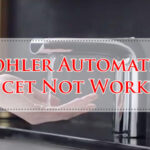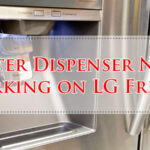If your Keurig won’t turn on after descaling, check if the brewer has reset. Unplug the machine, empty the water reservoir, rinse it, and restart the power.
Keurig often needs a reset after descaling due to the removal of minerals and chemicals from the water, which may interfere with the machine’s sensors. Keurig is a small and compact coffee maker that has changed the way people consume coffee.
Keurig’s convenience and ease of use have made it a popular choice for many coffee lovers. One common issue that Keurig users face is their machines not turning on after descaling, a process that helps remove buildup of mineral and calcium deposits in the machine. If your Keurig won’t turn on after descaling, don’t panic. There are several reasons why this might be happening, and in most cases, the issue can be quickly resolved. In this article, we will discuss the various reasons why a Keurig may not turn on after descaling and how you can troubleshoot the problem.

Potential Causes Of Keurig Not Turning On After Descaling
Keurig coffee makers are a convenient and quick way to get a cup of coffee without the hassle of grinding and brewing. However, when a Keurig won’t turn on after descaling, it can be frustrating. Descaling is an essential part of maintaining your coffee maker, but it can cause issues with the machine if not done correctly.
In this post, we’ll explore the potential causes of a Keurig not turning on after descaling, focusing on common issues such as electrical issues, clogged needles, water reservoir issues, dirty power buttons, and faulty circuit boards.
Electrical Issues
Electrical issues are perhaps the most common reason why a Keurig coffee maker won’t turn on after descaling. The machine may be failing to receive power due to faulty outlets or connections. Here are some of the key points to keep in mind if you suspect electrical issues with your coffee maker:
- Check to make sure that your Keurig is appropriately plugged in and that the outlet is working correctly.
- Ensure that the cord is not frayed or damaged in any way.
- Try plugging the Keurig into a different outlet or circuit to see if it turns on.
Clogged Needle
A clogged needle could be another reason why your Keurig won’t turn on after descaling. Descaling involves using vinegar or another descaling solution to remove buildup from the machine. Sometimes, this debris can clog the needle. Here are some of the main points to consider if you think your needle is clogged:
- Check to see if the needle is clogged by using a paper clip or another thin object.
- If the needle is clogged, use a needle-cleaning tool that comes with the coffee maker to remove any buildup.
- Run a cleansing brew cycle to flush out the system.
Water Reservoir Issues
Water reservoir issues can also cause a coffee maker to fail to turn on after descaling. The water reservoir is an essential part of any coffee maker, and if it’s not working correctly, it can cause a variety of problems.
Here are some of the key points to keep in mind:
- Check to make sure that the water reservoir is correctly seated in place.
- Ensure that the water reservoir is full and correctly attached to the coffee maker.
- If you’ve recently replaced the water filter, make sure it’s correctly installed.
Dirty Power Button
A dirty power button could also be the culprit if your Keurig isn’t turning on. Over time, the power button can become clogged with debris, making it challenging to engage the necessary circuits. Here are some of the things you can do if you suspect your power button is dirty:
- Clean the power button with a cloth or paper towel.
- Use a toothbrush to gently remove any excess debris.
- Apply a mild cleaning solution like vinegar or baking soda to gently clean the button.
Faulty Circuit Board
A faulty circuit board can be a severe issue and require replacement if it’s determined to be the cause of your coffee maker’s failure to turn on. Here are some of the key points to keep in mind:
- If you’ve exhausted all other possibilities, a faulty circuit board may be the problem.
- Contact Keurig customer service to explain the issue and determine if a circuit board replacement is necessary.
A Keurig not turning on after descaling can be frustrating, but it’s important to take a step back and troubleshoot the issue. The potential causes outlined above are the most common culprits for the problem. By working through each of these possibilities, you’ll be able to determine the cause of the issue and get your coffee maker up and running in no time.
How To Troubleshoot Electrical Issues
If you’re a Keurig owner, you may have faced issues with your machine not turning on after descaling. This can be frustrating, but before you start panicking, there are some simple steps you can take to troubleshoot electrical issues.
In this section, we’ll guide you through the process of identifying and fixing the problem.
Check the Source
The power source is the first thing you should check. Ensure that the power outlet you’re using works and is not defective. You can connect another device to the same outlet to be sure it’s not the source of the problem.
Additionally, check that the power cord is plugged in firmly and correctly.
Verify Power Button
Another thing to look at is the power button. Sometimes the button can get caught, or the connection may be loose. Check if the power button pops in and out well, and try to jiggle it a little. If the button isn’t functioning, you may want to consider replacing it.
Inspect Power Cord
If the power outlet and the power button are functioning correctly, the problem may be with the power cord. Check the cord for any signs of damage, such as fraying or cuts that may have damaged the cable. If you find any issues, you need to get a replacement as soon as possible.
Check For Electrical Surges
In rare cases, electrical surges can cause the Keurig to malfunction. These surges can occur when there’s a sudden drop or spike in electrical power. To solve the issue, unplug the Keurig for about a minute and then plug it in again.
This step could reset the electric system and solve errors.
Consider Voltage Fluctuations
Voltage fluctuations in the power source can cause the Keurig to malfunction. For example, plugging the Keurig machine into an outlet with too high or low voltage levels can cause it not to work. Ensure that the Keurig is plugged into a suitable power source with the required voltage levels.
By following these steps, you should be able to troubleshoot the electric issues and get your Keurig machine back up and running. Remember to use this guide as a reference for the future in case your Keurig runs into similar issues.
How To Fix A Clogged Needle
If you’ve recently descaled your Keurig but it still won’t turn on, there’s a good chance that the needle is clogged. A clogged needle can prevent your Keurig from brewing properly, which is why it’s essential to know how to fix it.
We’ll show you how to clear the clog and get your Keurig up and running again.
Unplug Keurig
Before working on your keurig, always unplug it to avoid any risk of electrocution. Make sure it’s entirely off and that the power cord is unplugged from the outlet.
Remove Needle
The needle is located at the top of the K-cup holder, and you’ll need to remove it to clean it properly. To do this, you can follow these steps:
- Lift the handle of your keurig to open the brewer.
- Carefully remove the K-cup holder from your Keurig.
- Look for the small needle at the bottom of the K-cup holder.
- Grip the needle with your pliers and gently pull it out.
Clear Needle With Pin Or Paper Clip
Once you’ve removed the needle, it’s time to clear the clog. Here’s what you need to do:
- Take either a pin or a paper clip and straighten it out.
- Carefully insert the pin or paper clip into the needle’s hole. (make sure it goes through the entire needle)
- Move the needle around gently to break up any blockages.
Reinsert Needle
After you’ve cleared the clog, it’s time to reinsert the needle. Here’s how to do it:
- Take the needle you just cleared and put it back into the k-cup holder.
- Gently push it back in until it’s secure in place.
Run Water Cycle
It’s always a good idea to run a water cycle after clearing the needle’s clog to ensure that everything is working correctly. Here’s how to do it:
- Fill the reservoir with fresh water.
- Place a large mug on the drip tray of your Keurig.
- Press the power button to turn on your machine.
- Run a hot water cycle into the mug.
- Discard the water collected and run another cycle to ensure that the clog is cleared, and the Keurig is back to normal.
If you’re experiencing problems with your Keurig not turning on, try clearing the clogged needle. Follow these instructions carefully, and you’ll have your machine up and running again in no time. Happy brewing!
Keurig won’t turn on after descaling: how to address water reservoir issues
How To Address Water Reservoir Issues
Keurig coffee makers are innovative machines that deliver a hot and fresh cup of coffee every time. However, at times, you can experience issues with your Keurig where it won’t turn on after descaling. One of the most common reasons for this issue is water reservoir problems.
Continue reading to learn about the steps you can take to address these issues.
Verify Water Level
Before checking for any other potential issues, ensure that your water reservoir has enough water. If the water level is low, the coffee maker won’t turn on. So, check to see if the water reservoir is full. If not, fill it with water and restart the machine.
Check Reservoir For Cracks
Water reservoir cracks and damage can prevent the Keurig from turning on. Look for any cracks or leaks on your water reservoir. If you spot any damage, it’s essential to replace the water reservoir.
Ensure Reservoir Is Properly Seated
If the keurig coffee maker does not turn on, it’s crucial to check if the water reservoir is appropriately seated. Remove the reservoir by pressing the release button and place it back into the machine, ensuring that it’s securely in place.
This step may solve the issue and allow the Keurig to turn on.
Clean Reservoir
If the water reservoir is dirty, it may cause issues with the Keurig machine. Make sure the reservoir is clean and free of any debris. To clean the reservoir, remove it from the water tank and wash it with soap and warm water.
Inspect O-Rings And Gaskets
O-rings and gaskets’ proper functioning is critical for the machine to work smoothly. If you see any cracks or damage on the o-rings and gaskets, replace them with new ones.
If your Keurig won’t turn on after descaling, water reservoir issues can be the culprit. To address these issues, check the water level, inspect the reservoir for cracks, ensure it’s appropriately seated, clean it, and inspect the o-rings and gaskets.
Following these steps will ensure your Keurig coffee maker is running smoothly, delivering a hot and fresh cup of coffee every time.
How To Clean A Dirty Power Button
Keurig coffee makers are great when they work, but they can be frustrating when they don’t turn on, especially after descaling. One of the most common issues is a dirty power button. However, don’t worry, in this section, we will teach you how to clean a dirty power button with some easy steps.
Unplug Keurig
Before cleaning the power button, you should always unplug your Keurig coffee maker to avoid electrical shock and damage.
Clean Power Button With A Dry Cloth
Take a clean, soft, dry cloth and gently wipe the power button and surrounding area to remove any dust or debris on the surface. Press the button a few times to ensure that no dirt or grime is stuck.
Wipe Again With A Damp Cloth
Dampen the cloth with water, and wring it out so that it’s slightly moist. Gently clean the power button again and make sure that no dirt or grime is left behind. Never spray water directly onto the coffee maker, as it may damage the internal components.
Let Dry Completely
Once you’ve finished cleaning, make sure to let it dry completely before plugging it back in or turning it on. Any moisture left behind can cause electrical problems and short circuits, which can damage your coffee maker.
Try Turning Keurig On
After ensuring that the power button is clean and dry, plug your Keurig coffee maker back in and try turning it on. If the power button still doesn’t work, you may have to take it to a professional technician. However, cleaning the power button often resolves the issue.
By following these simple steps, you can maintain your Keurig coffee maker and enjoy a warm cup of coffee whenever you need it without any hassle!
Frequently Asked Questions For Keurig Wont Turn On After Descaling
Why Won’t My Keurig Turn On After Descaling?
Your Keurig may not turn on after descaling due to a power supply issue or the machine needs a reset.
How Can I Fix My Keurig Not Turning On After Descaling?
Try resetting your Keurig by unplugging it for 5 minutes, checking the outlet, or contacting keurig support for further assistance.
Is It Safe To Use My Keurig After It Won’T Turn On Post Descaling?
No, it is not safe to use your Keurig if it won’t turn on after descaling. Do not attempt to use or fix the machine without proper support from Keurig.
Why Is Descaling Necessary For Keurig Machines?
Descaling removes mineral buildup in the Keurig machine and improves its performance, increases its lifespan, and maintains the quality of coffee served.
How Can I Prevent My Keurig From Malfunctioning After Descaling?
To prevent the keurig from malfunctioning after descaling, use distilled water and clean the machine daily after use, avoid using oily or sweetened coffee, and keep the machine away from direct sunlight and heat sources.
Conclusion
After going through this troubleshooting guide, you are now equipped with the knowledge to fix your Keurig machine that won’t turn on after descaling. Remember to always unplug the machine before attempting any repair process. Regular descaling is important to maintain the longevity of your Keurig machine, but it can also cause the machine to malfunction.
By conducting regular checks for any loose connections and clogs, you can prevent such issues from ever occurring. In the event that these solutions do not work, it might be best to seek professional assistance. It is essential to maintain the cleanliness and hygiene of your Keurig machine, and with proper care, you can get the most out of your coffee-making experience.
Don’t give up on your beloved brewer just yet, give these solutions a try, and you’ll have a fresh, hot cup of coffee in no time.





